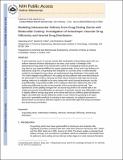Modelling intravascular delivery from drug-eluting stents with biodurable coating: investigation of anisotropic vascular drug diffusivity and arterial drug distribution
Author(s)
Zhu, Xiaoxiang; Pack, Daniel W.; Braatz, Richard D.
DownloadBraatz_Modelling intravascular.pdf (2.168Mb)
OPEN_ACCESS_POLICY
Open Access Policy
Creative Commons Attribution-Noncommercial-Share Alike
Terms of use
Metadata
Show full item recordAbstract
In-stent restenosis occurs in coronary arteries after implantation of drug-eluting stents with non-uniform restenosis thickness distribution in the artery cross section. Knowledge of the spatio-temporal drug uptake in the arterial wall is useful for investigating restenosis growth but may often be very expensive/difficult to acquire experimentally. In this study, local delivery of a hydrophobic drug from a drug-eluting stent implanted in a coronary artery is mathematically modelled to investigate the drug release and spatio-temporal drug distribution in the arterial wall. The model integrates drug diffusion in the coating and drug diffusion with reversible binding in the arterial wall. The model is solved by the finite volume method for both high and low drug loadings relative to its solubility in the stent coating with varied isotropic–anisotropic vascular drug diffusivities. Drug release profiles in the coating are observed to depend not only on the coating drug diffusivity but also on the properties of the surrounding arterial wall. Time dependencies of the spatially averaged free- and bound-drug levels in the arterial wall on the coating and vascular drug diffusivities are discussed. Anisotropic vascular drug diffusivities result in slightly different average drug levels in the arterial wall but with very different spatial distributions. Higher circumferential vascular diffusivity results in more uniform drug loading in the upper layers and is potentially beneficial in reducing in-stent restenosis. An analytical expression is derived which can be used to determine regions in the arterial with higher free-drug concentration than bound-drug concentration.
Date issued
2012-04Department
Massachusetts Institute of Technology. Department of Chemical EngineeringJournal
Computer Methods in Biomechanics and Biomedical Engineering
Publisher
Taylor & Francis
Citation
Zhu, Xiaoxiang, Daniel W. Pack, and Richard D. Braatz. “Modelling Intravascular Delivery from Drug-Eluting Stents with Biodurable Coating: Investigation of Anisotropic Vascular Drug Diffusivity and Arterial Drug Distribution.” Computer Methods in Biomechanics and Biomedical Engineering 17, no. 3 (April 18, 2012): 187–198.
Version: Author's final manuscript
ISSN
1025-5842
1476-8259